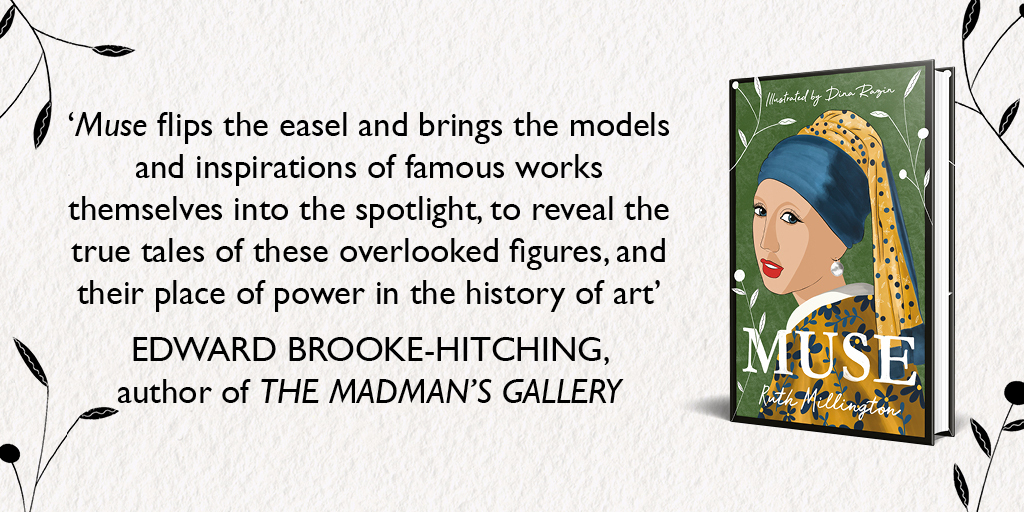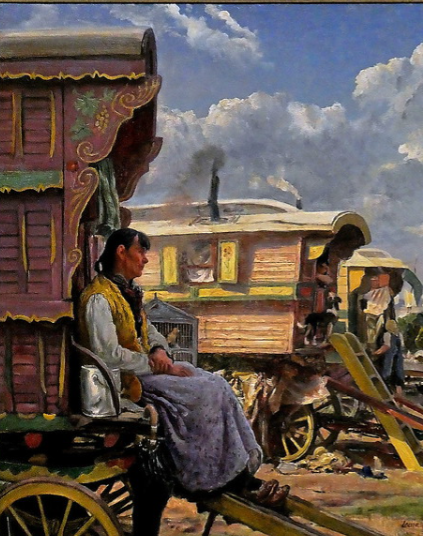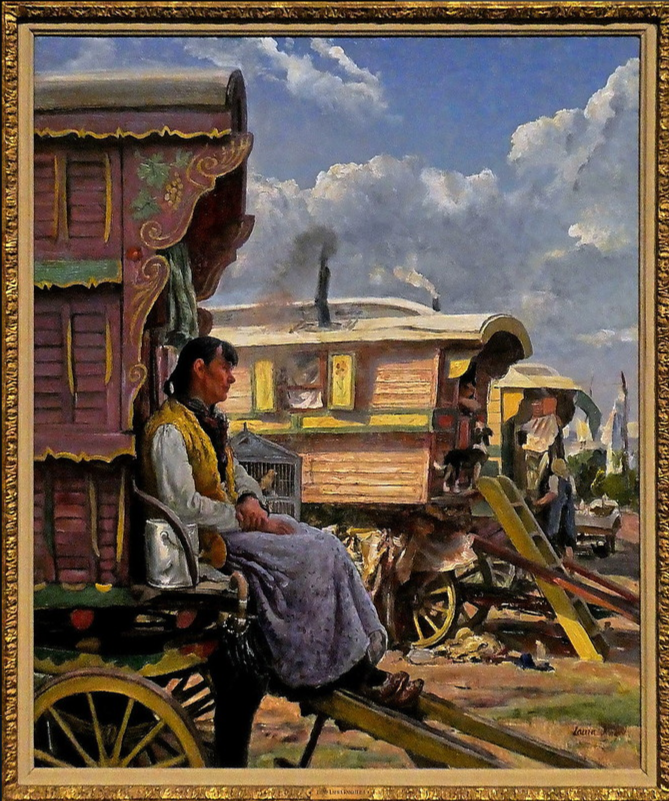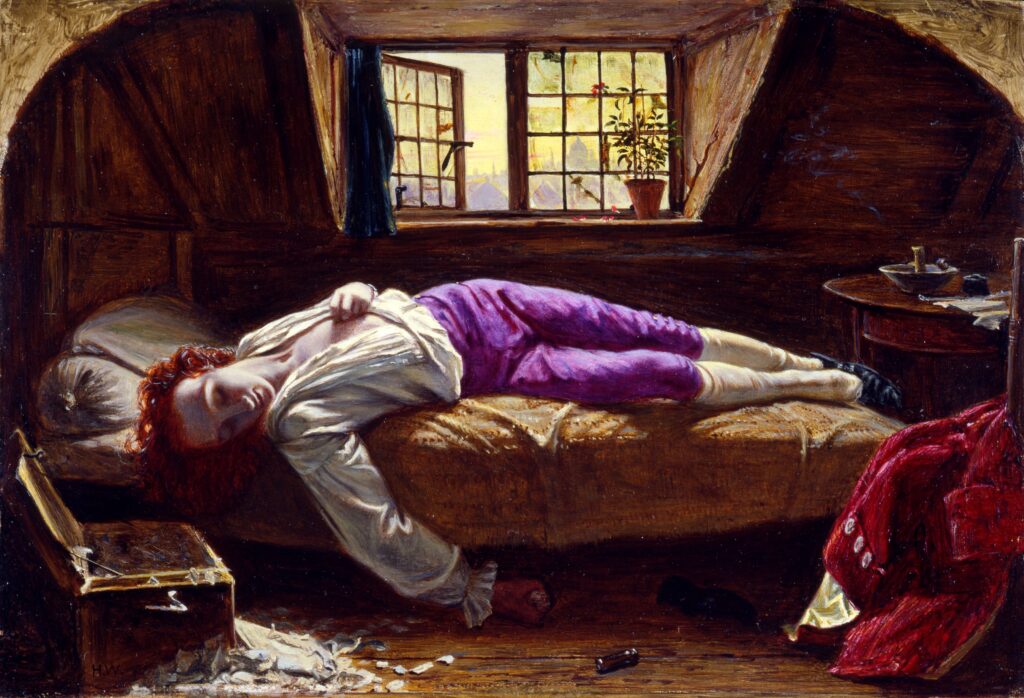Sitting on the steps of her painted wagon, the Roma woman in ‘Gypsy Encampment’ (c.1930s) extends her legs, lost in thought. To one side of her, a silver jug catches the light, while on the other perches a caged bird. It’s as if her day’s work can wait. This quiet moment was captured by Dame Laura Knight (1877–1970), whose exhibition ‘I Paint Today’ is currently on show at Worcester City Art Gallery and Museum.
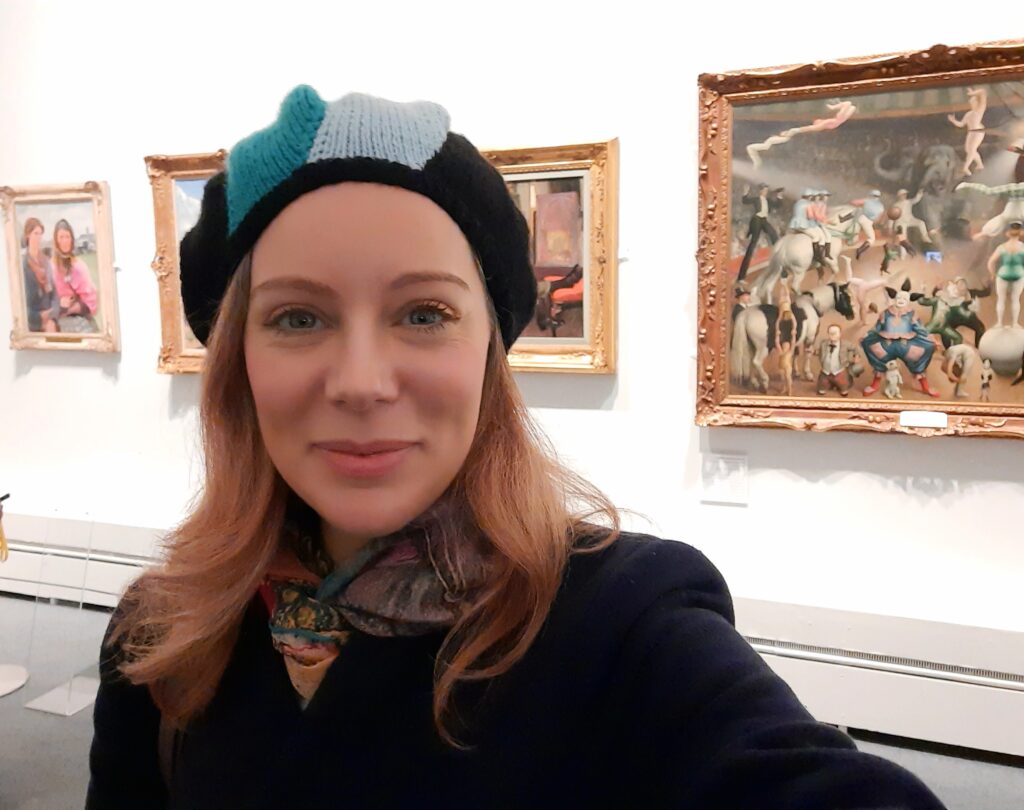
Pushing at the boundaries of portraiture, Knight turned her female gaze on members of marginalised communities; among them, Roma travellers and circus performers. However, rather than frame these muses as exotic curiosities, she painted them with humanity.
Knight first befriended many of her sitters at the races: in ‘Gypsies at Ascot’ (c.1930s) two women appear watchful of the artist. Following encounters like this, Knight was invited to visit these women’s settlements, where she spent many months immersing herself in their everyday lives; there’s an implicit trust in more intimate portraits such as ‘Beulah, No.2’ (c.1930s) in which her model’s eyes are closed.
In contrast to these depictions of rest, Knight painted dynamic circus scenes. Surrounded by a packed audience, the stage of ‘The Grand Parade’ (1929) is filled with performers who climb dangerously high ropes, fly through the air, and share the stage with several galloping horses, a sealion and an elephant.
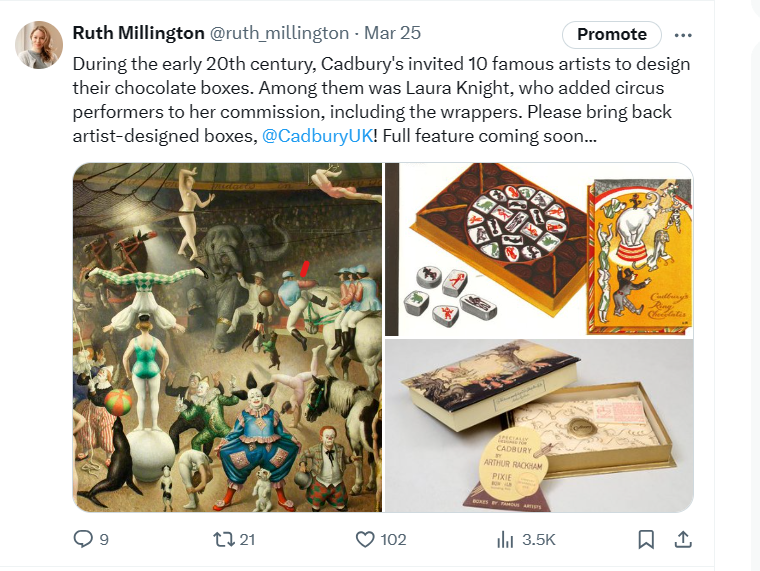
In 1933, Knight transferred the drama of the circus to a more surprising surface – that of the chocolate box. Wanting to package products in a way that would be “strikingly different from any previously seen in the shops”, Cadbury’s invited ten artists to create a design for their ‘Famous Artists’ series. Knight added a clown, elephant and horses to her illustration, which covered even the wrappers. Also commissioned by the Cadburys and included in the show is an endearing double portrait of Briony Cadbury and the family dog, ‘Briony and Sally’ (1930s).
Birmingham-based connections continue throughout the exhibition, as Knight and her husband Harold were close friends with the theatre director, Barry Jackson. The Knights were present at many memorable performances at the Birmingham Repertory theatre, which saw the emergence of some of the most important actors and actresses on the 20th century stage.
In ‘Marjorie Mars as Henrietta Moulton-Barrett’ (c.1930s), Knight has depicted the West End actress in a sumptuous dress designed by the Birmingham Rep’s designer-in-residence, Paul Shelving. But she pauses, waiting to make her entrance onstage, having climbed up the backstage steps which were carpeted to ensure quiet. Two other actors in Victorian costumes are glimpsed standing in the background.
Seeking a behind-the-scenes view, Knight would often sketch her subjects in the dressing room, echoing the paintings of Edgar Degas. Deliberately depicting actors as they were being dressed for their parts, as well as the stage’s support structures, she exposes the real-life creativity behind Jackson’s theatrical illusions.
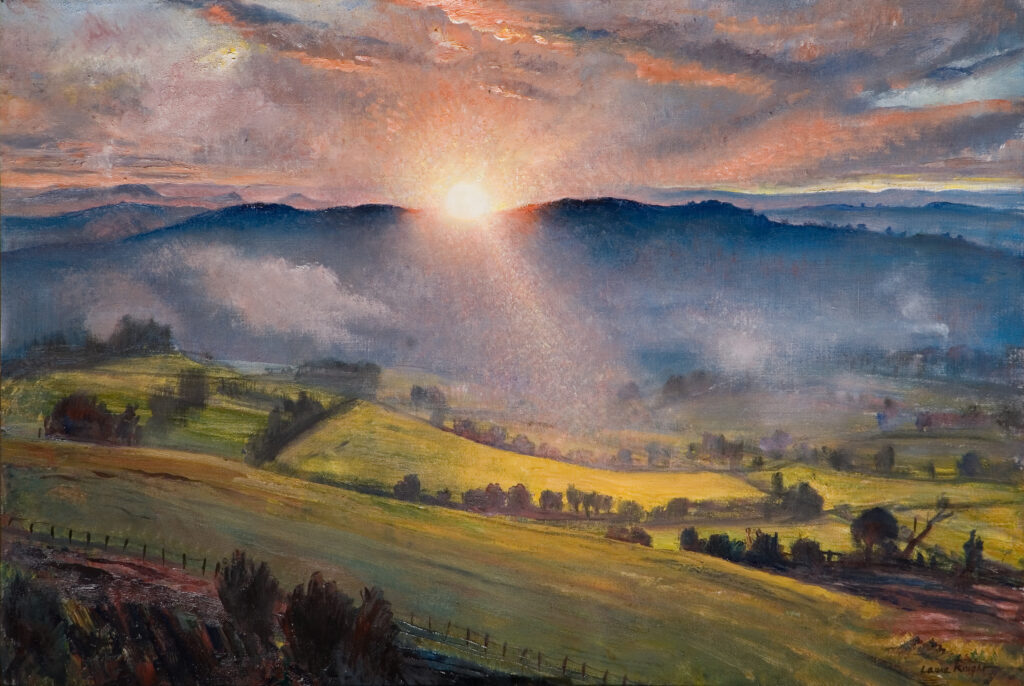
Through her friendship with Jackson, she was also introduced to another site of inspiration: Malvern. In 1931, the director invited the Knights to his Literary Festival in Malvern, following which the pair returned year upon year to holiday and to paint. In ‘Sundown’ (c.1955) Knight has depicted the setting sun head on, as it casts its rays across the hillside.
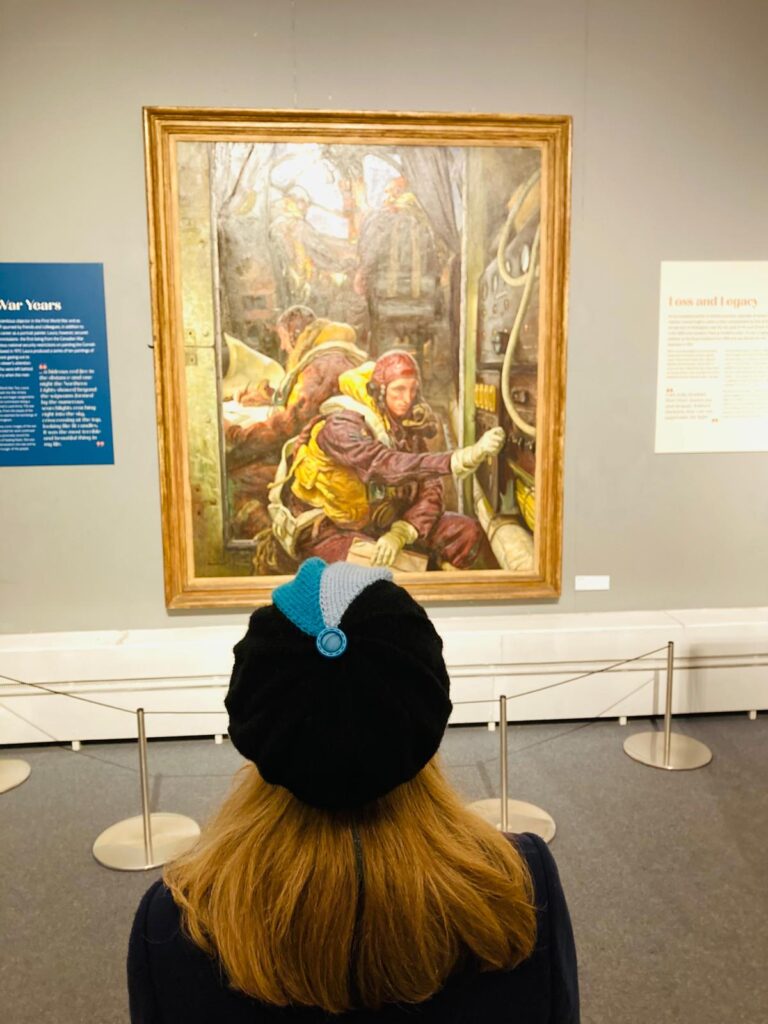
Towards the end of 1939, and feeling unsafe as war loomed, the Knights decided to leave London and settle in Malvern permanently, making it their home. From here, Knight continued to paint landscapes, while also working on major commissions as a British official war artist.
A masterpiece of the exhibition, ‘Take Off’ (c.1943), which is on loan from the Imperial War Museums, depicts RAF crew inside a cramped plane, preparing for their take off. While working on this painting, Knight lived in the WAAF Officers’ Mess for several months, once again immersing herself in her subjects’ lives. The result is an empathic view of the young crew, one of whom was killed in action.
In 1929, Knight was proud to be made a dame, and she was the first female to be elected as a Royal Academician since the 18th century in 1936. While celebrating one of Britain’s most important artists, this exhibition also shines a light on the significant regional influences, which are too often overlooked.
Deborah Fox, Senior Curator at Museums Worcestershire says:
“We have received an amazing response with people coming from across the Midlands and beyond to see this exhibition which celebrates the extraordinary life and prolific work of Dame Laura Knight.
We are particularly pleased to revisit Laura’s connections both with the landscapes of Worcestershire and with Birmingham through her links with the Cadbury family and theatre producer and director Barry Jackson. We hope many more people will enjoy the exhibition before it closes in June.”
With this compelling exhibition, Worcester City Art Gallery and Museum proves that Knight was not only one of Britain’s most prolific painters, but one of its best. “I paint today,” she once said, declaring her commitment to capturing the everyday, which she framed in refreshingly sincere depictions of modern life.
Dame Laura Knight – I Paint Today runs until 30 June at Worcester City Art Gallery and Museum, open Tuesday – Saturday 10am – 4pm and Sunday 10am – 3pm. This is a paid-for exhibition and tickets can be booked at www.museumsworcestershire.org.uk. The rest of the Art Gallery & Museum is free to visit.
An illustrated map of Dame Laura Knight’s links to Malvern, created especially for the exhibition, can be purchased from the Art Gallery & Museum and Malvern Tourist Information Centre.
